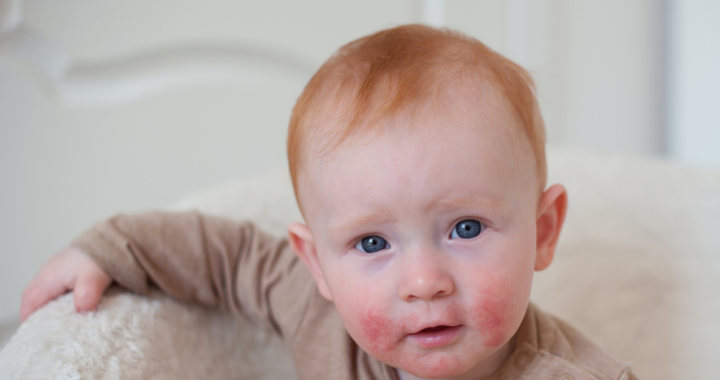Atopic dermatitis in children is a very common skin condition. In fact, 10 to 20 percent of children are diagnosed with atopic dermatitis, with 65 percent of children showing symptoms before they turn one and 90 percent showing symptoms before they turn five.
Although atopic dermatitis is the most common skin condition in children, the rash associated with it can be mistaken for other rashes. So, let’s take a deeper dive into atopic dermatitis in children – what causes it, symptoms to look out for, and the different types of atopic dermatitis treatment in children.
What is Atopic Dermatitis?
Atopic dermatitis is a chronic skin condition that causes dry, itchy skin. It’s very common in infants and children, typically first appearing between three and six months of age, but can flare up throughout adulthood. Atopic dermatitis is not contagious, but scratching the skin can lead to scarring and the constant itchiness can result in a lower quality of life.
Does this make atopic dermatitis sound like eczema? If you said yes, that’s because atopic dermatitis is actually one of the different types of eczema.
What Causes Eczema in Children?
There are actually different causes of eczema in children based on the type of eczema your child is experiencing, but those with a family history of eczema, asthma, and allergies are more likely to develop it. Is this the same for atopic dermatitis in children? Yes and no.
Because atopic dermatitis is a type of eczema, the causes and triggers of eczema in children should also be monitored in children with atopic dermatitis. In addition to the general causes of eczema, atopic dermatitis is also caused by a genetic variation that makes it harder for your child’s skin to protect itself from allergens, bacteria, and irritants.
A compromised immune system or an immune system that is not fully formed can cause atopic dermatitis as the immune system helps your child’s skin protect itself. External factors can also be to blame for flare ups. Common external factors that cause flare ups of atopic dermatitis in children can be winter weather, hot water, harsh soaps or detergents, and dry, hot temperatures.
What is the Major Symptom of Atopic Dermatitis in Children?
Atopic dermatitis in children is often characterized by a rash that is itchy and scaly. This skin rash in children can become bumpy or change colors, becoming lighter or darker based on your child’s skin tone. Other common symptoms to look out for include severe itching, redness and swelling, and thickened skin.
Atopic dermatitis symptoms can come and go, with worsening symptoms considered a flare up. You may notice that these symptoms become worse at night for your child. Symptoms can affect any area of the body. Infants are more likely to have the scalp, face, neck, elbows, and knees affected, and children are more likely to be affected around the mouth, the sides of the neck, and wrists, ankles, and hands.
Typical symptoms of atopic dermatitis in children may not require a dermatologist appointment, but there are some symptoms that are a sign you need to call your child’s pediatric dermatologist, especially since children with atopic dermatitis are more prone to skin infections. Symptoms you should call your dermatologist about right away are:
- Areas of the skin that look like cold sores
- Pus-filled bumps around the area(s) affected by atopic dermatitis
- Redness or warmth around affected area(s)
- Fever
Will My Child Outgrow Atopic Dermatitis?
With proper treatment and medication, atopic dermatitis can be well managed. As your child ages, flare ups can become less prevalent, with flare ups in half of all children affected by atopic dermatitis improving by the age of 15.
Although atopic dermatitis in children is not curable, it is important to remember that it is not a life-threatening condition and is not contagious.
What is the Best Treatment for Atopic Dermatitis in Children?
The first step to receiving atopic dermatitis treatment in children is to receive a diagnosis. You’ll discuss the family’s medical history and the dermatologist will examine your child’s skin. A skin biopsy may be needed to verify atopic dermatitis as the diagnosis.
While there is no cure for atopic dermatitis in children, your pediatric dermatologist can work with you and your child to create an individualized treatment plan that combines at-home and professional treatment options. This treatment plan can keep skin moisturized, help reduce flare ups, ease symptoms, and lower the risk of infection.
At-home remedies that may be included in your child’s treatment plan include moisturizing your child’s skin throughout the day, having your child take warm baths/showers (rather than using hot water), using a humidifier, and choosing gentle or mild facial and skin products. During a flare up, you can also apply an anti-itch cream to your child’s skin or have them take an anti-itch medication. You will also want to determine what triggers your child’s flare ups and avoid those triggers as often as possible.
If your child continues to have flare ups or the flare ups are diminishing their quality of life, your pediatric dermatologist will prescribe medications to help manage your child’s atopic dermatitis. Prescription creams such as corticosteroid and non-steroidal anti-inflammatory creams can be used on localized areas to control itching, reduce redness, and help repair the skin barrier. If your child’s atopic dermatitis is more severe or widespread, short term oral steroids or long term systemic non-steroidal pills or injectable medications can aid in management.
Our pediatric dermatologist in Pittsburgh, Dr. Elizabeth Froelich, has more than 15 years of experience treating atopic dermatitis in children. If you’re interested in scheduling an appointment with Dr. Froelich, you can reach our team at 412-429-2570 or visit our contact page to book your appointment. You can also follow us on Facebook to see what’s new in the world of dermatology.

